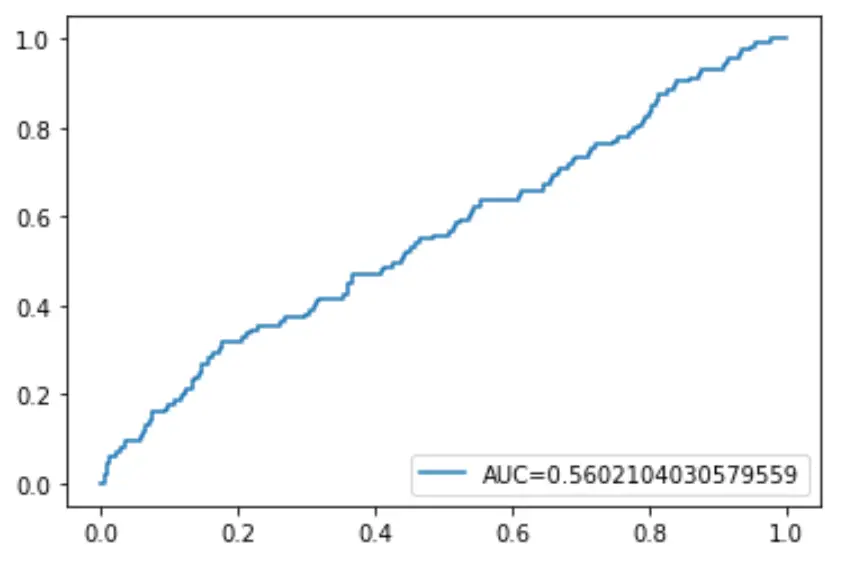本教程中使用的完整 Python 代码可以在此处找到。
如何在 python 中执行逻辑回归(逐步)
当响应变量是二元时,逻辑回归是我们可以用来拟合回归模型的方法。
逻辑回归使用称为最大似然估计的方法来查找以下形式的方程:
log[p(X) / ( 1 -p(X))] = β 0 + β 1 X 1 + β 2 X 2 + … + β p
金子:
- X j :第 j个预测变量
- β j :第 j个预测变量的系数估计
方程右侧的公式预测响应变量取值 1 的对数几率。
因此,当我们拟合逻辑回归模型时,我们可以使用以下方程来计算给定观测值为 1 的概率:
p(X) = e β 0 + β 1 X 1 + β 2 X 2 + … + β p
然后我们使用一定的概率阈值将观察结果分类为 1 或 0。
例如,我们可以说概率大于或等于 0.5 的观测值将被分类为“1”,所有其他观测值将被分类为“0”。
本教程提供了如何在 R 中执行逻辑回归的分步示例。
第1步:导入必要的包
首先,我们将导入必要的包以在 Python 中执行逻辑回归:
import pandas as pd import numpy as np from sklearn. model_selection import train_test_split from sklearn. linear_model import LogisticRegression from sklearn import metrics import matplotlib. pyplot as plt
第2步:加载数据
对于此示例,我们将使用《统计学习简介》一书中的默认数据集。我们可以使用以下代码来加载并显示数据集的摘要:
#import dataset from CSV file on Github url = "https://raw.githubusercontent.com/Statorials/Python-Guides/main/default.csv" data = pd. read_csv (url) #view first six rows of dataset data[0:6] default student balance income 0 0 0 729.526495 44361.625074 1 0 1 817.180407 12106.134700 2 0 0 1073.549164 31767.138947 3 0 0 529.250605 35704.493935 4 0 0 785.655883 38463.495879 5 0 1 919.588530 7491.558572 #find total observations in dataset len( data.index ) 10000
该数据集包含 10,000 人的以下信息:
- 违约:表明个人是否违约。
- 学生:表明个人是否是学生。
- 余额:个人持有的平均余额。
- 收入:个人的收入。
我们将使用学生身份、银行余额和收入构建逻辑回归模型,预测给定个人违约的概率。
第 3 步:创建训练和测试样本
接下来,我们将数据集分为用于训练模型的训练集和用于测试模型的测试集。
#define the predictor variables and the response variable X = data[[' student ',' balance ',' income ']] y = data[' default '] #split the dataset into training (70%) and testing (30%) sets X_train,X_test,y_train,y_test = train_test_split (X,y,test_size=0.3,random_state=0)
步骤 4:拟合逻辑回归模型
接下来,我们将使用LogisticRegression()函数将逻辑回归模型拟合到数据集:
#instantiate the model log_regression = LogisticRegression() #fit the model using the training data log_regression. fit (X_train,y_train) #use model to make predictions on test data y_pred = log_regression. predict (X_test)
第 5 步:模型诊断
一旦我们拟合了回归模型,我们就可以分析模型在测试数据集上的性能。
首先,我们将为模型创建混淆矩阵:
cnf_matrix = metrics. confusion_matrix (y_test, y_pred)
cnf_matrix
array([[2886, 1],
[113,0]])
从混淆矩阵我们可以看出:
- #真实阳性预测:2886
- #真实的负面预测:0
- #误报预测:113
- #假阴性预测:1
我们还可以获得准确率模型,它告诉我们模型做出的校正预测的百分比:
print(" Accuracy: ", metrics.accuracy_score (y_test, y_pred))l
Accuracy: 0.962
这告诉我们,该模型在96.2%的情况下对个人是否会违约做出了正确的预测。
最后,我们可以绘制接收者操作特征(ROC)曲线,该曲线显示当预测概率阈值从 1 降低到 0 时模型预测的真阳性百分比。
AUC(曲线下面积)越高,我们的模型预测结果就越准确:
#define metrics
y_pred_proba = log_regression. predict_proba (X_test)[::,1]
fpr, tpr, _ = metrics. roc_curve (y_test, y_pred_proba)
auc = metrics. roc_auc_score (y_test, y_pred_proba)
#create ROC curve
plt. plot (fpr,tpr,label=" AUC= "+str(auc))
plt. legend (loc=4)
plt. show ()
